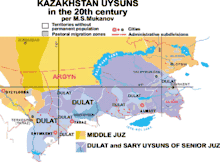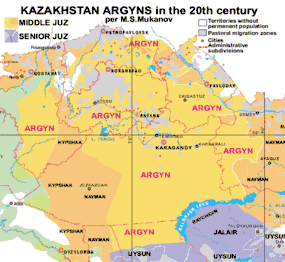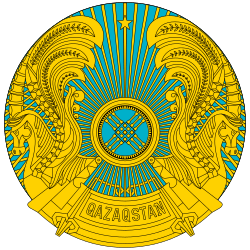Zhuz
A zhuz (Kazakh: жүз, romanized: júz, ٴجۇز, pronounced [ʑʏz], also translated as "horde" or "hundred") is one of the three main territorial and tribal divisions in the Kypchak Plain area that covers much of the contemporary Kazakhstan, and represents the main tribal division within the ethnic group of the Kazakhs.
- The Senior zhuz (Kazakh: Ұлы жүз, romanized: Uly júz, ۇلى ٴجۇز) or Uly zhuz covers territories of southern and southeastern Kazakhstan, northwestern China (Xinjiang) and parts of Uzbekistan.
- The Middle zhuz (Kazakh: Орта жүз, romanized: Orta júz, ورتا ٴجۇز) or Orta zhuz consists of six tribes, covering central and eastern Kazakhstan
- The Junior zhuz (Kazakh: Кіші жүз, romanized: Kishi júz, كىشى ٴجۇز)) or Kishi zhuz consists of three tribes, covering western Kazakhstan and western Russia (Orenburg Oblast).

History
The earliest mention of the Kazakh zhuz or hordes dates to the 17th century. Velyaminov-Zernov (1919) believed that the division arose as a result of the capture of the important cities of Tashkent, Yasi, and Sayram in 1598.[1]
Some researchers argued that the zhuz in origin corresponded to tribal, military alliances of steppe nomads that emerged around the mid-16th century after the disintegration of the Kazakh Khanate. Yuri Zuev argued their territorial division comprises three ecological or topographic zones, the Senior zhuz of the southern and southeastern steppe being set apart from the two other zones by Lake Balkhash.
According to some researchers, Kazakhs was separated in the first civil war in the Kazakh Khanate. Tribes that recognized Buidash Khan formed Senior zhuz. Tribes that recognized Togim Khan formed Middle zhuz. Tribes that recognized Akhmed Khan formed Junior zhuz.
According to Kazakh legends, the three zhuz were the territorial inheritances of the three sons of the mythical founder father of the Kazakhs. In Kazakh language, júz means either "union" or "hundred".
Senior zhuz

Historically, the Senior zhuz (Kazakh: Ұлы жүз, romanized: Uly júz, ۇلى ٴجۇز; Russian: Старший жуз, romanized: Staršij žuz) inhabited the northern lands of the former Chagatai Ulus of the Mongol Empire, in the Ili River and Chu River basins, in today's South-Eastern Kazakhstan and China's Ili Kazakh Autonomous Prefecture (northern Xinjiang). It was also called Üysin jüz.
The first record of the Senior zhuz dates to 1748, due to a Tatar emissary of the Tsaritsa who had been sent to the steppe to negotiate the submission of Abul Khair Khan in 1732. According to Nikolai Aristov, the estimated population of the Senior zhuz was about 550,000 people in the second half of the 19th century. The territory was conquered by the Kokand Khanate in the 1820s, and by the Russian Empire during the 1850s to 1860s.
Kazakhstan's ruling elite, including former president Nursultan Nazarbayev, former First Secretary of the Communist Party of Kazakhstan Dinmukhamed Konayev, as well as famous poet Jambyl Jabayev are representatives of the Senior zhuz.
There have been several attempts to determine the exact names and nature of top-level clans throughout the 19th and early 20th centuries. However, different studies created vastly different names and population numbers for the steppe clans. Generally accepted names of the first order Senior zhuz tribes or clans are:
- Dulat (Kazakh: Дулат, romanized: Dýlat, دۋلات)
- Jalayir (Kazakh: Жалайыр, romanized: Jalaıyr, جالايىر)
- Qangly (Kazakh: Қаңлы, romanized: Qańly, قاڭلى)
- Alban (Kazakh: Албан, romanized: Alban, البان)
- Suwan (Kazakh: Суан, romanized: Sýan, سۋان)
- Sary-Uysin (Kazakh: Сары-үйсін, romanized: ' 'Sary-úısin, سارى-ۇيسىن “Yellow Uysin”)
- Shapyrashty (Kazakh: Шапырашты, romanized: Shapyrashty, شاپىراشتى)
- Sirgeli (Kazakh: Сіргелі, romanized: Sirgeli, سىرگەلى)
- Oshaqty (Kazakh: Ошақты, romanized: Oshaqty, وشاقتى)
- Ysty (Kazakh: Ысты, romanized: Ysty, ىستى)
- Shanyshqyly (Kazakh: Шанышқылы, romanized: Shanyshqyly, شانىشقىلى)
Middle zhuz

The Middle zhuz (Kazakh: Орта жүз, romanized: Orta júz, ورتا ٴجۇز; Russian: Средний жуз, romanized: Srednij žuz), also known as Arǵyn júz, occupies the eastern lands of the former Golden Horde, in central, northern and eastern Kazakhstan.
Some of Kazakhstan's famous poets and intellectuals were born in the Middle zhuz territories, including Abay Qunanbayuli, Akhmet Baytursinuli, Shokan Walikhanuli and Alikhan Bokeikhanov.
The Middle zhuz consists of the following tribes:
- Argyn (Kazakh: Арғын, romanized: Arǵyn, ارعىن)
- Kerei (Kazakh: Керей, romanized: 'Kereı, كەرەي)
- Naiman (Kazakh: Найман, romanized: Naıman, نايمان)
- Khongirad (Kazakh: Қоңырат, romanized: Qońyrat, قوڭىرات)
- Qypchak (Kazakh: Қыпшақ, romanized: Qypshaq, قىپشاق)
- Taraqty Kazakh: Тарақты, romanized: Taraqty, تاراقتى)
- Uwaq|Waq (Kazakh: Уақ, romanized: Úaq, ۋاق)
Junior zhuz
The Junior or Lesser zhuz (Kazakh: Кіші жүз, romanized: Kishi júz, كىشى ٴجۇز; Russian: Младший жуз, romanized: Mladšij žuz), also known as Alshyn júz, occupied the lands of the former Nogai Khanate in Western Kazakhstan. It was also called Alshyn júz.
They originate from the Nogais of the Nogai Horde, which once was placed in Western Kazakhstan, but in the 16th century it was defeated by the Kazakhs and the Russians and Nogais retreated to the Western part of their khanate, to the Kuban River steppes. In the 18th century, they endangered inner Russian cities, so the Russian Empire allied the Mongolic Kalmyks to supplant Alshyns back to the Urals. There they formed the Lesser zhuz. During Kazakh-Kalymk struggles, Khiva Khanate annexed Mangyshlak Peninsula for repelling Kalmyk raids and managed it for two centuries before Russian conquest. At the beginning of the 19th century, Kazakhs shifted some to the west, to Astrakhan Governorate, forming Bukey Horde there. As the Kazakh SSR was formed with Bukey Horde as the most remoted its western part, situated geographically in Europe.
Historical leaders of Kazakh resistance against the Russian Empire associated with the Junior zhuz include Isatay Taymanuly (Kazakh: Isataı Taımanuly, 1791—1838) and Makhambet Otemisuly (Kazakh: Mahambet Ótemisuly, 1803/4–1846).
The Junior zhuz consisted of three groups, subdivided into clans:
- Baiuly (Kazakh: Байұлы, romanized: Baıuly, بايۇلى)
- Adai (Kazakh: Адай, romanized: Adaı, اداي)
- Alasha (Kazakh: Алаша, romanized: Alasha, الاشا)
- Baibaqty (Kazakh: Байбақты, romanized: Baıbaqty, بايباقتى)
- Berish (Kazakh: Беріш, romanized: Berish, ء بەرىش)
- Zhappas (Kazakh: Жаппас, romanized: Jappas, جاپپاس)
- Masqar (Kazakh: Масқар, romanized: Masqar, ماسقار)
- Taz (Kazakh: Таз, romanized: Taz, تاز)
- Tana (Kazakh: Тана, romanized: Tana, تانا)
- Esentemir (Kazakh: Есентемір, romanized: Esentemir, ء ەسەنتەمىر)
- Ysyq (Kazakh: Ысық, romanized: Ysyq, ىسىق)
- Qyzylqurt (Kazakh: Қызылқұрт, romanized: Qyzylqurt, قىزىلقۇرت)
- Sherkesh (Kazakh: Шеркеш, romanized: Sherkesh, شەركەش)
- Alimuly (Kazakh: Әлімұлы, romanized: Álimuly, ء الىمۇلى)
- Qarakesek (Kazakh: Қаракесек, romanized: Qarakesek, قاراكەسەك)
- Qarasaqal (Kazakh: Қарасақал, romanized: Qarasaqal, قاراساقال)
- Tortqara (Kazakh: Төртқара, romanized: Tórtqara, ء تورتقارا)
- Kete (Kazakh: Кете, romanized: Kete, كەتە)
- Shomekei (Kazakh: Шөмекей, romanized: Shómekeı, ء شومەكەي)
- Shekti (Kazakh: Шекті, romanized: Shekti, ء شەكتى)
- Jetyru (Kazakh: Жетіру, romanized: Jetirý, ء جەتىرۋ)
- Tabyn (Kazakh: Табын, romanized: Tabyn, تابىن)
- Tama (Kazakh: Тама, romanized: Tama, تاما)
- Kerderi (Kazakh: Кердері, romanized: Kerderi, ء كەردەرى)
- Kereit (Kazakh: Керейт, romanized: Kereıt, كەرەيت)
- Zhagalbaily (Kazakh: Жағалбайлы, romanized: Jaǵalbaıly, جاعالبايلى)
- Telew (Kazakh: Телеу, romanized: Teleý, تەلەۋ)
- Ramadan (Kazakh: Рамадан, romanized: Ramadan, رامادان)
See also
- Kazakh tribes
- Kazakh Khanate
- Zhetysu
- Ethnic demography of Kazakhstan
- List of medieval Mongolian tribes and clans
- Orda (structure)
References
- Velyaminov-Zernov, "Russia, Mongolia, China in the 16th, 17th, and early 18th centuries". Vol II. Baddeley (1919, MacMillan, London). Reprint – Burt Franklin, New York. 1963 p. 59.
- Муканов М. С., Этническая территория казахов в 18 – нач. 20 вв ("Ethnic territory of Kazakhs from the 18th to the beginning of the 20th century"), Almaty, 1991.
Literature
- Svat Soucek, "A History of Inner Asia". Cambridge University Press (2000). ISBN 0-521-65704-0.
- W. W. Bartold, Four studies in history of Central Asia, Leiden: E.J. Brill, 1962.
- Ilkhamov Alisher et al., "Ethnic Atlas of Uzbekistan", Uzbekistan, "Open Society Foundation", 2002, p. 176, ISBN 978-5-86280-010-4 (in Russian)
- Isin A., "Kazakh khanate and Nogai Horde in the second half of the 15th - 16th centuries", Semipalatinsk, Tengri, 2002, p. 22, ISBN 978-9965-492-29-7 (in Russian)
- S. Qudayberdiuli. "Family tree of Turks, Kirgizes, Kazakhs and their Khan dynasties", Alma-Ata, Dastan, 1990 (in Russian)
- S. Kudayberdy-Uly, Family tree of Türks, Kyrgyz, Kazakhs and their Khan dynasties, Alma-Ata, Dastan, 1990 (in Russian)
- M. Tynyshbaev, 'The Uysyn', in Materials on the history of the Kazakh people, Tashkent 1925 (in Russian)
- Yu.A. Zuev, "Ethnic History of the Usuns", Works of the Academy of Sciences of the Kazakh SSR, History, Archeology And Ethnography Institute, Alma-Ata, Vol. 8, 1960. (in Russian)
- А. Т. Толеубаев, Ж. К. Касымбаев, М. К. Койгелдиниев, Е. Т. Калиева, Т. Т. Далаева, перевод с казахского языка С. Бакенова, Ф. Сугирбаева. — История Казахстана. Изд-во «Мектеп», 2006 г. — 240 с ISBN 9965-33-628-8
External links
- Genealogy of the Kazakhs (in Kazakh and Russian)
